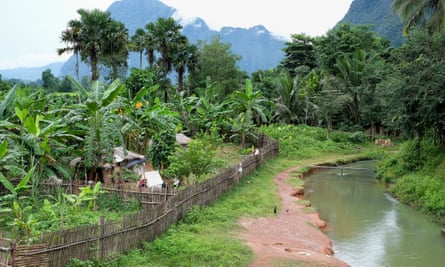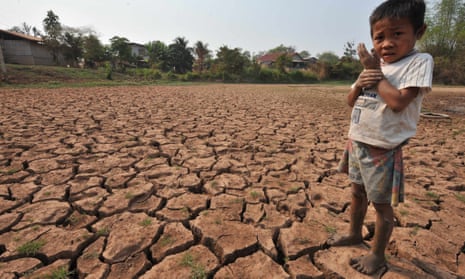Namai village in remote, mountainous central Laos has seen immense change in just 20 years. Its isolation only ended when a road was pushed up the valley in 2003, and electricity came several years later.
Today Namai villagers mostly have televisions and refrigerators but they, and thousands of other communities, face a new set of problems that are forcing them to develop in ways they never imagined.
“Since 2000 it has definitely been getting hotter,” says San Sayyachan, a young teacher, during a meeting of 40 people last month in the village’s Buddhist temple, restored with help from former Namai residents living in Japan. “We are seeing many new cattle diseases. Our buffaloes are dying faster. We get sore throats and dengue. Our children have colds and diarrhoea more.”
Ka Soukhamay, a mother-of-three, says: “There are fewer fish in the river. We can no longer drink water from the river. The rivers flood at different times. The water comes higher and the water quality is lower.”
Some villagers link Namai’s troubles to deforestation, others blame a nearby dam, which they say has affected river flows. Yet more say growing rice with pesticides has made the river water undrinkable.
But the villagers are unanimous in saying that the greatest threat facing Namai now is natural disaster – in the form of cyclones, storms, floods and drought. Over the past 10 years, say village leaders, they have seen record floods, droughts and landslides, which have thrown their lives into turmoil.
“In the past, we would get floods perhaps once every three years,” says farmer Link Vorvong Xay. “This year, it has already flooded three times. The rises [in the river levels] come at different times of the year and more quickly than they used to. In the past, it always started raining in June and ended in October. Now the rains start in August and they have not ended yet. The rains are heavier and changing.”

Many villagers say they have lost most or all of their rice crops and have had to find other work to survive. Some grow cucumbers to be sold in the capital, Vientiane; others have taken up weaving.
Similar stories are being told across Laos and in neighbouring countries. In Phong Soung province, villagers report disruptions to harvests or planting seasons, rising temperatures, infestations of insects, and livestock diseases.
“The rice does not grow so well. We have had to replant. We are seeing more insects, which damage the rice. There is a pattern emerging of extreme weather. We realise that erratic temperatures have increased,” says Boumlouay Vongsay, in Phonbong village.
Lao scientists agree with the villagers. “Temperatures are definitely rising. The rains are certainly later and sometimes heavier. Rice is the staple crop, and climate change risks the food security of thousands of villages,” says Chay Bounphanousay, deputy director of Laos’s National Agriculture and Forestry Research Institute, where scientists and growers are working to develop new rice varieties that can withstand drought, floods and heat waves.
Every 1C increase in temperature, Bounphanousay says, can result in a 10% decrease in rice yield.
In Laos, as in other countries in south-east Asia, only 13%-14% of food is grown on irrigated land – meaning more droughts can have a devastating effect. At the same time, villagers are losing, through neglect, hundreds of their 14,000 traditional rice varieties, some of which have traits that may be ideal for breeding into new “climate-proofed” varieties.
“We have many drought-tolerant varieties, but only one flood-tolerant one. We are crossing them with other varieties,” says Bounphanousay, adding that farmers need to adapt and use more diverse seeds.
“We are going to communities all over Laos, setting up schools of 20 to 30 farmers, helping them to choose varieties that are suitable for them. In the north, they are having more landslides, in the south there is more flooding.”
Bounphanousay, herself a farmer, set up the first national gene bank and says she is encouraging villages to set up their own seed banks, and advising them to cut back on pesticides and adopt more agroecological practices to adapt to the erratic weather.
She recommends that farmers use the system of rice intensification (SRI), which needs less water and fewer inputs and has been shown to improve yields significantly. “SRI has great potential. You need to work harder, but it can increase yields,” she says.
International groups, working with local Lao partners, are now helping villagers to adapt on a community level in various ways, but the scale of what is needed for the tens of thousands of communities in the country and across the region is immense, Oxfam said in a May report, Harmless Harvest.
In neighbouring Vietnam, farmers who use SRI have increased their income by $200 per hectare. This has encouraged others to start applying SRI principles in their farms, the report says. “By 2011, more than 1 million farmers [in Cambodia], equivalent to around 10% of the national farming population, were adopting this approach. According to the government, SRI principles are now being applied in 16% of rice lands in the northern part of Vietnam and 6% of total rice lands in the country. Farmers report that they were able to increase yield by as much as 68%.”
But adaptation to climate change requires more than training. Farmers need early warning systems and accurate climate information to help them better anticipate extreme weather events, says Oxfam. Countries need investment in technology, communications, infrastructure, institutions, training and outreach, among many other things.
“Rainfall in Cambodia, Laos, Thailand, Myanmar and Vietnam has been below average since 2009, resulting in droughts, lower yields and more pest and disease infestations,” say the authors. “Damages to agriculture wrought by disasters like these cost billions of dollars. Early warning systems, localised weather forecasting and climate data collection would save many a harvest from being submerged.”The Asian Development Bank has estimated the adaptation cost for agriculture and coastal areas in just Thailand, the Philippines, Vietnam and Indonesia to be $5bn per year by 2020. Expanded to all developing countries, the cost would run to hundreds of billions of dollars.
“Climate change adaptation is coming at high costs, especially to the rural poor,” says Ibrahim Thiaw, deputy executive director of the United Nations Environment Programme. The UNEP Adaptation Gap Report, released in December 2014, estimated that the cost of climate adaptation would be as much as $150bn a year. Others have suggested much more.

So far less than $5bn has been allocated to climate adaptation, by Oxfam’s estimate. But at the UN climate negotiations in Paris next week, developing countries will be holding rich countries to their pledge, made in 2009, to mobilise $100bn a year by 2020.
The Paris talks are likely to hinge not on the figure, which is broadly agreed by rich countries, but on whether rich countries pay a fair share of the money needed by developing countries to adapt. This, say many developing countries, should be calculated on the historical emissions of rich countries and their ability to assist poorer nations financially.
When these factors are taken into acount, the burden falls mainly on the US and Europe, whose emissions since the Industrial Revolution have been the greatest. According to ActionAid, the US should increase grants to $67.5bn a year and the EU to $36.9bn.
“Up to now, rich nations have been sitting around plucking numbers out of thin air to pretend to deal with the climate crisis,” said ActionAid senior policy analyst Brandon Wu. “Meanwhile, people in poor countries are already battling its vicious storms.”








Comments (…)
Sign in or create your Guardian account to join the discussion